How to create a content calendar that actually works
Many content teams publish content without a real plan. Sure, they might have a spreadsheet with some publish dates, but that’s not a content calendar—that’s a wish list.
The end result? One-third of B2B marketers find their content strategy lacking due to unclear goals, absence of data, or poor message-market fit, according to Content Marketing Institute’s 2025 Outlook.
What separates high-performing content teams from others? Is it better writers? Bigger budgets?
More often than not, it’s the planning.
To go from random content ideas to a revenue-generating pipeline, you need to plan a content calendar. High-performing content teams are focused on proactively planning for all known elements by developing a content calendar that establishes topical authority and supports their overall marketing goals with a well-rounded strategy.
Let’s cover some best practices for creating a content calendar that works for your business and aligns with your core goals.
6 key elements of an effective content calendar
To establish a successful content strategy, your content calendar should include the following necessary elements:
1. Target audience
Start your planning with the most critical element: your audience.
A target audience is the specific group of people you aim to reach with your marketing messages, products, or services. Identifying your target audience helps tailor content, improve engagement, and increase conversions. You want to get to know what your audience needs, how they prefer to get this information, and even what language they use so that you can package your content in a way that best resonates with them.
Without knowing whom you’re creating content for, you’re just throwing spaghetti at the wall and creating a mess that someone else will eventually have to clean up, exponentially increasing the total expected cost of your content production initiatives.
You might not even want to create content for everyone in your industry. There may be particular roles or segments that tend to convert better, so you’ll want to invest your content production efforts accordingly.
Define your target audience, which is more than just demographics: it’s about what they need. Get specific about:
- What demographics are of interest: Do you want to target specific ages, geographies, education levels, etc.? You’ll want to track engagement over time and possibly even test different content for each demographic.
- What content formats do they prefer: A C-suite executive may prefer a one-page document versus a marketing newbie who might like a comprehensive how-to guide.
- When/in what situations they’re most likely to engage: Do they prefer organic search or social media? Do they primarily explore when they’re shopping around, or do they spend a lot of time looking for expert content?
- What pains drive their decisions: Does everyone in the industry struggle with specific questions or issues? Are there specific incidents or recurring events that drive recurring concerns at particular time points? Do these pain points evolve over the course of a career?
Pro tip: If you’re having trouble finding answers to these questions, Semrush’s Market Explorer offers a lot of these insights.
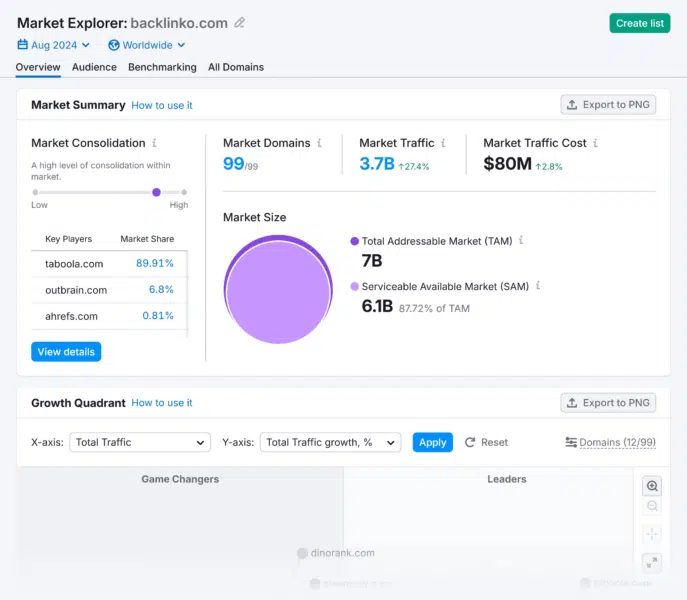
For instance, a DevOps automation platform can identify that its core audience consists of senior developers who consume technical tutorials and security-focused content.
Conversely, retail store owners may want some 101 content on using your SaaS solution, meaning your marketing efforts should likely focus on high-level use cases and ease of use.
2. Content goals
Ultimately, the point of creating a content calendar is to develop a strategic plan with specific guidance for execution. It’s important to go into this process with clear content goals. If you’re not clear on your goals, start there before planning any individual content assets.
A content goal is a clear, strategic objective that drives the creation and distribution of content, such as increasing website traffic, generating leads, or boosting audience engagement. Content goals align with overall business and marketing objectives to ensure each piece of content delivers measurable value.
Let’s be honest, “More traffic” and “better engagement” don’t count as fully-formed content goals. Those aren’t real goals, they’re starting points for discussion.
To create a strategic plan that supports business growth, you need to get a lot more specific than “increase traffic and engagement.” For attainability and accountability, your goals need to be SMART: specific, measurable, achievable, related, and time-bound.
Here are some example goals to guide your efforts:
SEO performance goals:
- Increase quarter-over-quarter organic traffic by 14%, having reached that number based on what competitors are doing and what sort of growth is reasonable for your website
- Rank in the top three for a specific list of target keywords within six months
- Acquire 25 high-quality backlinks in the next quarter (following an internal discussion of what “high-quality” means for your business, and tempered by what’s reasonable given peer performance)
Pro tip: You can use Semrush’s Position Tracking to monitor your SEO progress and easily adjust your content calendar in response to updates.
For instance, you can track how your DevOps automation content performs for key terms—such as “CI/CD pipeline setup”—to identify which topics need more supporting content.
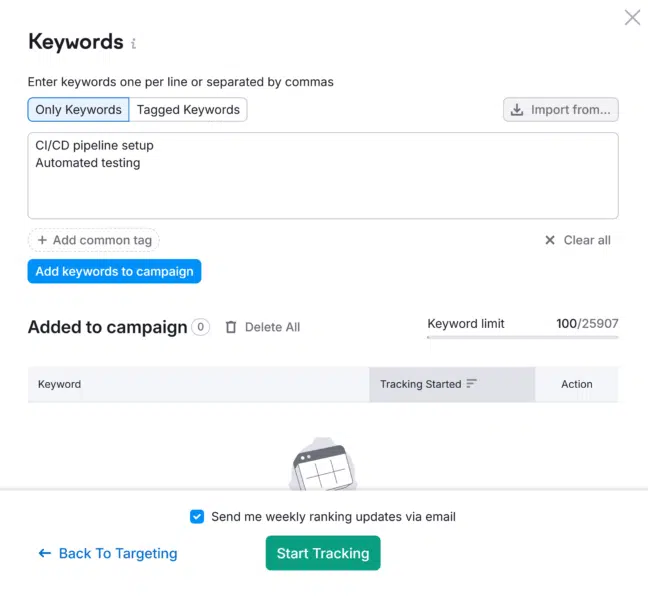
Engagement metrics goals:
- Achieve 35+ comments per post
- Get 100+ social shares per article
- Improve average time on page to over two minutes
Lead generation goals:
- Convert 3% of blog leaders to newsletter subscribers
- Generate 20 qualified leads per month
- Achieve 6% click-through rates on calls to action
Specificity is important. But make sure that you can answer the “Why?” for setting these goals before finalizing them.
For example, if you’re looking for 100+ social shares per article, your reasoning may relate to specific brand-building initiatives. You may know that the biggest players in your industry consistently score 1k+ shares per article, and so your ultimate target is 1K+ per post.
But you also need to make sure you’re shooting for realistic goals and building up from there. For example, 1K+ social shares per article is likely an unreasonable goal if you’re starting from scratch and having to build the audience up. Instead, break that larger goal down into attainable chunks while you build social media momentum.
Wix Dominated ‘How to Start a Blog’ Keyword for 2+ Years Using Semrush
✓ Find high-volume keywords you can actually win
✓ See which content deserves strategic schema markup
✓ Identify quick-win featured snippet opportunities
Free instant insights.
3. Content types
You’ll need to consider the various content formats your team might produce to meet audience needs.
It can be helpful to first consider how you consume information. It probably doesn’t fit into a neat box of one type of content. For example, you might enjoy blog posts when you’re looking for career advice, podcasts while you’re commuting or doing chores, visual aids or infographics to help explain complex technical topics, etc.
Now put yourself in your target audience’s shoes. Your audience consumes content in different ways, too. And your calendar needs to reflect that.
For business content, this mix of formats may include:
Written content:
- Long-form blog posts
- Company news or product updates
- Transcribed interviews
- Tutorials/how-tos
- White papers
- Case studies
Visual content:
- Infographics
- Data visualizations
- Tutorial videos
- Expert interviews
- Product demos
- Quizzes
Social media content:
- LinkedIn posts
- Twitter/X threads
- Instagram carousels or Reels
- TikTok shorts
- Facebook updates
- Google My Business profiles & updates
Pro tip: While diversifying content helps, start small and nail one or a few types of content before expanding. A big part of successful content strategy is testing different formats and refining until you find the qualitative sweet spot that works.
Trying to do all of these things at once when you’re building a content program from scratch or scaling to the next level is an operational nightmare.
Build your content calendar with the Pareto principle (or 80/20 rule) in mind: 80% of positive outcomes are the result of 20% of efforts. Instead of trying to be perfect and nailing 100% of everything from the get-go, focus on what’s good enough. More than likely, the audience you’re trying to reach responds well to some of these content formats, whereas others are ultimately not worth the effort with your particular target. Get comfortable with testing and finding your way forward.
Industry-specific content examples
Starting from a blank page isn’t a great way to overcome writer’s block.
Having great content examples in your calendar is like having a content recipe book (also known as a swipe file) that the team can use for inspiration.
Depending on your industry, here’s what you might need in your swipe file:
| SaaS company: | Ecommerce: | B2B services: |
| Product update blogsComparison guidesIntegration tutorials | Buying guidesProduct roundupsSeasonal gift guides | Research reportsCase studiesThought leadership pieces |
For instance, your DevOps SaaS company can include the following in your swipes:
- Integration tutorials, like GitLab’s CI/CD guides
- Deployment automation guides
- Tool comparison articles (such as “Jenkins vs. [your solution]”)
Pro tip: There’s nothing wrong with being inspired by yourself—include your team’s greatest hits in your swipes.
4. Content planning tools
As you start to make decisions and flesh out your approach, you’ll need a place to manage your content calendar plan. You’ll want to have resources ready for quick research and for tracking success.
There’s no need to overcomplicate things if you just want to get started and don’t want to get stuck on evaluating and learning how to use different tools.
Google Sheets and Google Docs are great no-frills options. They’re not as robust or shiny as solutions built strictly for content calendar planning, but otherwise fit the organization needs of small-scale operations.
If you’re working with a larger team or seek additional functionality, you may also want to layer in:
- Google Calendar for high-level planning
- Semrush for topic research and SEO
- A project management tool (such as Trello) for workflow tracking
Later in this guide, we’ll share more in-depth guidance about content calendar tools and how to implement them in your workflow.
5. Content timelines
As your content plan starts to come together, you should consider the importance of being realistic when planning content workflow stages, deadlines, and publishing dates based on team resources and budget.
Here’s an example timeline and corresponding workflow stages to use as a baseline that can be adjusted for the way your team operates:
- Research and planning: 2-3 days
- Topic research
- Keyword analysis
- Competitor review
- Content brief creation
- Content creation: 5-7 days
- First draft (3-4 days)
- Expert review (1-2 days)
- Visual assets (3-5 days)
- CMS/platform build (2-3 days)
- Review process: 3-4 days
- Content + visual edits (1-2 days)
- Stakeholder approval (1-2 days)
- Legal review (if needed)
If your content requires sourcing subject matter expert insights or advanced design needs, account for these stages in the timeline.
Seasonal content or pieces timed around specific events will need to be factored into your content calendar, and this is where a workback schedule is key. A workback schedule is a planning tool that starts with a final deadline and works backward to map out all the tasks and milestones needed to meet that goal. It helps teams allocate time efficiently, identify dependencies, and stay on track throughout a project.
Pro tip: Life happens! Add at least a 20% buffer to the timeline to account for unforeseen circumstances.
Selecting the date and time to publish is arguably both an art and a science. You’ll want to research optimal publish days and times for your industry; look at what the top competition does and suss out any trends. You’ll also want to test different dates on your own audience to confirm they work.
For example, does a webinar on Tuesday mid-morning or Thursday afternoon work better? How far in advance of the holidays should you launch end-of-year content? These parameters can be extremely important to driving successful engagement.
6. Content KPIs
As management guru Peter Drucker has been misquoted as saying, “What gets measured gets managed.”
Considering this, it’s important to set the right key performance indicators (KPIs) for your content calendar. The specific KPIs to track will vary by the particular brand, department, and content goals. Your content goals should drive each metric, tying back each piece of content to some aspect of the business.
Ideally, you would decide the KPI for measurement before you even produce the content. You might settle on a target value by the time you go live with content, informed by competitor benchmarks for similar topics and similarly-sized audiences.
You will want to do an initial check within the first week after launch and then check back in within anywhere from 2 to 4 weeks. Depending on engagement trends, you might choose to further optimize your content, to wait, or to “call it” and pivot strategy.
Remember how you will use these KPIs:
- To decide whether each piece of content is successful or could potentially benefit from further enhancements
- To report back to internal stakeholders on marketing successes or potential opportunities
Start by defining the core KPIs to track, which might include:
- Traffic: Page views
- Engagement: Comments and shares
- Conversion: Email signups and leads
- Revenue: Attributed sales
Additionally, you can also map your KPIs to your content types.
For example, thought leadership posts will likely want to factor in social shares or industry mentions as a measure of authority being recognized within the industry. Product-led content might take a closer look at business conversion metrics like product page visits or demo requests. SEO-focused content might look at keyword rankings or organic traffic growth, and compare trends against competitor performance for helpful context.
Pro tip: Use Semrush’s My Reports tool to create custom dashboards for each content type’s KPIs.
If a piece of content misses the mark on a KPI, this doesn’t have to be considered a troubling failure—rather, it’s a learning opportunity. Maybe you learn that a particular topic doesn’t resonate after all, or perhaps you discover a meaningful insight about your target audience.
For example, an article that has low page views but high conversion rates is still successful because you’ve targeted a niche audience that finds the content relevant. Something that’s meant to be high-converting that drove lots of traffic but converted poorly is an opportunity to look at the conversion pathing from that resource to see if it can be optimized/improved.
Step-by-step guide to creating a content calendar
With an understanding of the key elements that make up a content calendar, let’s put it all together.
Step 1: Perform a content audit
Unless you’re making a content calendar for a new business that has yet to create content, you need to know where you stand.
You must consider relevant data gathered about what’s been working and what hasn’t.
Start with your analytics:
- Which content gets the most traffic? These are most likely the content types you’ll want to drill down into the most.
- What topics convert best? You will want to expand on these topics, producing more content across content types and content channels. You may also find logical next steps that flow from these topics. For example, if a certain SaaS feature is generating a lot of buzz, how-to guides around implementation or KPIs might be the logical next step, followed by more complex analysis or expert interviews, etc.
- Where does your content fall flat? You can’t do everything, so data that indicates what to pause or deprioritize is helpful. This doesn’t have to mean shutting the door on these topics forever; it just means that right now, for the audience you’re reaching, this content is not worth investing time and resources that are better spent on higher-converting initiatives.
Then, check your SEO performance (using an auditing tool like Semrush’s Site Audit) for:
- Top-performing keywords that can help drive topic selection
- Content gaps in your strategy that are next-step priorities
- Backlink opportunities you’re missing, but that can provide inspiration for the types of content or answers your audience is looking for
In particular, pay attention to pieces that rank on page two, since this content is on its way to ranking well—it just needs a little nudge for proper Google recognition. Updating this content with a fresh strategy can be a quick win. Sometimes just a little optimization or additional content around specific target keywords is enough to bump the piece to page one (or at least improve rankings).
You will likely want to classify your content into one of three categories, although the metrics defining each category vary according to your website and industry:
- Performing well: While you may always want to optimize your content further, these are likely safe to leave as-is for now to maintain good performance while you focus your limited resources elsewhere.
- Needs improvement: These might be on page two or three and in need of a little nudge. You see promise in these pieces, but they need a bit of optimization to really do better. These are your team’s priority to work on next. Consider optimizing around specific keywords, questions that commonly arise, and possibly integrating graphics and/or video to help give your target audience more substance to dig into.
- Not performing: Got content that’s not seeing any traction? You might want to retire it and redirect the pages to your blog or some other helpful section.
Step 2: Plan content theme and topics
Writing and publishing random blog posts is not a strategic plan.
You need themes that tie everything together, especially due to entity-based SEO.
Think of entity-based SEO as Google connecting the dots between related content pieces. When you consistently write about those connected topics, Google sees you as an authority in that space.
To start, lock down your foundational themes using keyword research tools like Semrush’s Topic Research tool.
For a DevOps automation platform, you might discover connected themes that strengthen your topical authority, like CI/CD pipelines, quality assurance, and deployment strategies.
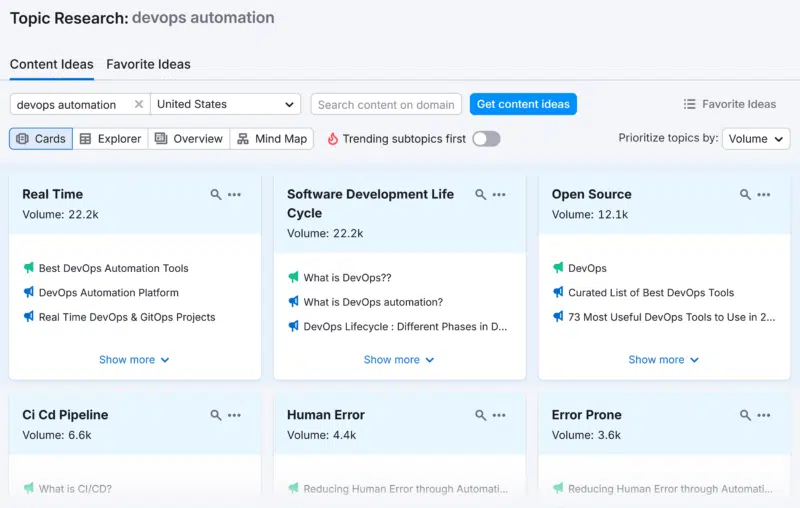
Focusing on topic clusters when you plan out content can help you easily spot where to place:
- Product information: Feature deep dives, integration guides, and use cases
- Industry authority: Trend analysis, data-backed research, and expert interviews
- Customer wins: Case studies and implementation guides
- How-to content: Step-by-step tutorials, best practices, and troubleshooting guides
Much of this content approach involves “evergreen” content, which is content that’s intended to be useful and relevant over time. The goal behind evergreen content is to build a solid foundation of primarily organic traffic that forms a steady stream of site engagement.
Of course, industries and businesses experience all kinds of events. You’ll also want to consider more timely content needs for:
- Product launches (check search demand for similar features)
- Market analysis using trending industry terms
- Seasonal campaigns based on historical search trends
- Conference coverage by monitoring event-related keywords
You should plan these into your content calendar, using a workback schedule to ensure alignment on all necessary components (key product details, design assets, and even external links in the case of PR) being delivered in a timely manner.
The end result of blending both evergreen and timely content into your calendar?
A content calendar that encapsulates both pillar content for your topic clusters and event-driven content for flexibility.
There is no magic recipe for how much content should be timely or evergreen. When you’re just starting out, it’s helpful to have over half of your content be evergreen, just so you can start to stack some long-term gains and build your platform. With this solid foundation of expertise and content in place, your timely content carries more meaning.
Pro tip: Use Semrush’s Keyword Magic Tool to find related ideas and questions for each content theme.
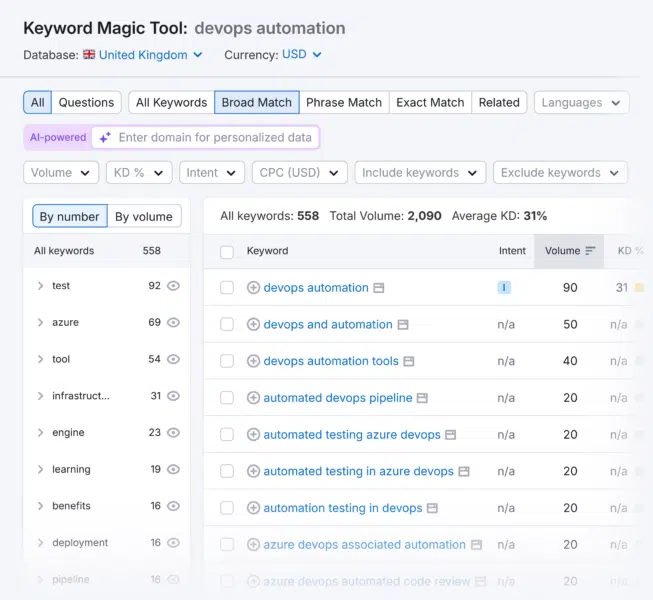
For example, here’s what the January content mix could look like for a DevOps SaaS company:
Core pillar:
- Advanced CI/CD pipeline optimization guides
- Comparison guides
Event-driven, seasonal:
- Annual infrastructure planning frameworks
- Coverage of major security patches
Step 3: Choose the right format for your calendar
You don’t need a fancy tool to start constructing an effective content calendar. As mentioned, Google Sheets can handle the essential functions of building a content calendar that’s useful, particularly if you’re just starting out with a small team. Done is always better than perfect.
But you may want to consider adopting a more robust project management tool that helps connect your team of collaborators and stakeholders, particularly as your content production becomes more complex.
Using a spreadsheet for your content calendar
Best for: Small teams and solo creators
Spreadsheets are free, flexible, and easy to customize.
Semrush’s content calendar template is a good example of how you can create a useful content calendar in a collaborative spreadsheet.
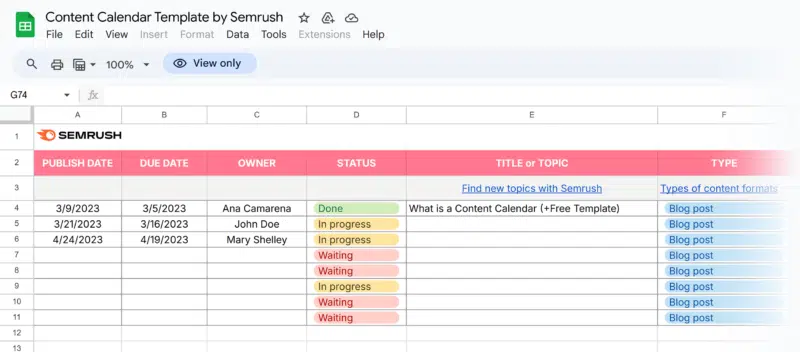
PROS:
- Free
- Straightforward and simple to use
- Easily customizable
CONS:
- Can’t easily attach files or visual assets
- Vulnerable to bloat with too many fields, tabs, etc.
- Challenging to designate assignments or track progress across multiple phases
Tracking content production via project management tool
Best for: Midsized teams (5-15 people)
Tools like Trello or Asana help with collaboration with features that include:
- Kanban boards for content workflow
- Timeline view for publication schedule
- Task assignments and deadlines
- File attachments and comments
Check out Trello’s content calendar template for an example of how a project management tool can be used to build and manage a content calendar.
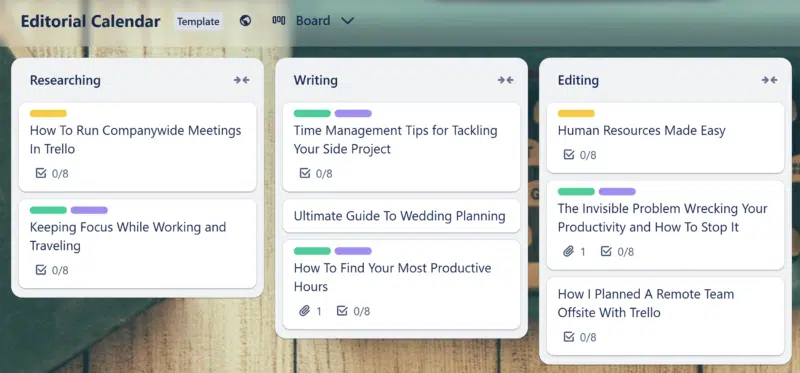
PROS:
- Better for collaboration
- Easier to manage assets
- Simpler to visual project progress
CONS:
- Cost
- Often easier to use while tracking content published on a single distribution channel, e.g., a blog
Implementing a dedicated content calendar tool
Best for: Large teams (16+) and agencies
Platforms like CoSchedule help with:
- Advanced workflow automation
- Team capacity planning
- Analytics integration
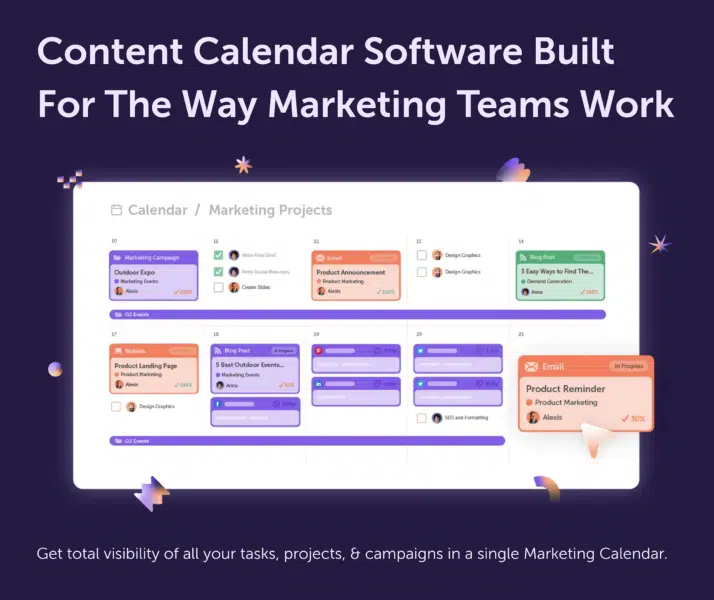
If you’re looking for inspiration on how to structure each distribution channel’s view, check out these content calendar examples from Semrush.
PROS:
- Simplest collaboration
- Easiest to manage assets
- Clearest visualization of project progress
- Quickly manage multiple distribution channels
CONS:
- Cost
- Learning curve
Step 4: Schedule content
It’s already been said, and it’s worth saying again:
There’s no room for random in your strategic content planning efforts. Create focus and consistency by sticking to a schedule. This helps you implement findings (or perform tests) around what days and times content performs best, while also reinforcing expertise through consistent content production.
Of course, guidelines differ by industry, brand, and the specific content formats you’re creating on target platforms. You should always research what your industry competitors are doing to have a finger on the pulse of what resonates in the real world.
But if you’re just starting out, here are some general guidelines to use as a baseline for your efforts:
- Blog posts: Publish 2-3x per week. Publishing a minimum of 2 blogs per week yields strong results, Orbit Media’s 2024 Blogger Survey found.
-
Social media: Daily. Using your own data will yield the best results, but you can start with Hootsuite’s recommendations:
- Instagram: 3-5 posts per week
- Facebook: 1-2 posts per day
- X (Twitter): 2-3 tweets per day
- LinkedIn: 1-2 posts per day
- Newsletter: Weekly or monthly, depending on your resources
Next, map out the content workflow for each piece in terms of specific action dates and stage owners:
- Content manager: Sets topic and final publication date (3-4 days)
- Writer: Gets draft deadline and revision timeline (2 weeks)
- Editor: Schedules review and feedback windows (3-4 days)
- Design team: Books time for visual asset creation (1 week)
The exact schedule still depends on your team’s bandwidth, seasonal trends, and planned product launches. That said, make sure to create room and flexibility for trending topics, customer requests, and breaking industry news. When something time-sensitive takes priority, you might need to push down some evergreen content or add it to a backlog. It’s helpful to have at least a few pieces in your backlog so that if other content takes longer than expected to produce, you don’t fall behind on your publishing goals.
You may also try using your set content pillars to plan related needs. For instance, if you’re writing for an “email marketing” pillar, plan to create content covering all related topics (for example, how to write effective subject lines, best practices for list building, how to set up automation) in the same month to build authority on the pillar as a whole.
Tools and resources for content calendar management
From simple spreadsheets to complex integrations, these content calendar tools can make your life so much easier.
Popular content calendar tools
As we discussed earlier, multiple options exist, depending on the size of your operations and needs.
For content planning, consider any or all of the following:
- Google Calendar
- Trello, Monday, Asana, or similar project management tools
- Notion or Confluence
For analytics, Semrush is your go-to for:
- Tracking performance
- Finding keywords
- Optimizing content
Putting it together, a great solution for most teams is:
- Google Calendar for tracking timeline details
- Trello or other project management tool for task management
- Notion for Confluence for storing organizational knowledge, including your content style guide
- Semrush for SEO and content strategy intelligence
That said, you can accomplish a lot with the basics—Google Sheets and Semrush—and add more tools to your stack as your needs grow.
When evaluating content calendar tools, consider native integrations and the ability to connect apps externally with solutions like Zapier.
As you develop your brand’s approach to content planning and execution, these features will help you scale efficiently.
Integrations and automation
Unless you’re planning to invest in building a custom solution, your tools will need to play nicely together. Set up integrations that help you with your content calendar.
Here are a few high-level integrations to consider:
Planning + analytics
- Connect Google Calendar with Semrush
- Automatically create calendar events with deadlines and team assignments when scheduling content in Semrush
- Receive calendar reminders for publication dates and SEO tasks
Task management + SEO
- Import keyword data into your project management tool
- Track content rankings alongside tasks
- Automate status updates to keep team members in the loop
ROI tracking
- Connect Google Analytics 4 (GA4) to track conversion paths
- Integrate customer relationship management (CRM) data to monitor content-driven leads
- Use tracking data to adjust your content plan as needed
Pro tip: You can set up many of these integrations with custom APIs or Zapier’s pre-built templates
Let’s say you want to analyze the wins and losses of your content game at the DevOps SaaS company.
Here’s an example workflow:
- Send the links to content published in the last 90 days from Google Calendar to Semrush via Zapier
- Configure Semrush to get position tracking and pull keyword rankings
- Send over data collected from Semrush to ChatGPT (or your preferred AI solution)
- Configure a prompt for the AI tool to analyze the Semrush data, such as determining your best and worst performers by organic traffic growth
- Create a monthly Google Calendar event for a standing meeting, with the AI analysis shared in the event description
Common mistakes to avoid when creating a content calendar
A content calendar is a useful marketing tool, but it can be a burden/problem if it’s not built effectively.
It can quickly become that overly ambitious pre-exam study schedule many of us made but could never stick to. An overly strict plan can create more problems than it solves because real life is not as perfect as the plans we make ahead of time.
To steer clear of a similar end result, avoid these mistakes.
Overloading the calendar with unrealistic deadlines
A plan to publish 20 blog posts in a month may sound like a great goal, but achieving it involves being honest about available resources.
If you push through regardless of real limitations, you can expect burnout, missed deadlines, and rushed content that may not achieve important brand quality standards.
✓ To fix deadline issues, reassess your content volume while being realistic. Build in buffer time for unexpected circumstances.
Pro tip: Start your content calendar planning with half the content you think you can handle. You can always scale up.
Ignoring data from past content performance
Don’t create content based on your gut feelings, especially because you’re probably not the target audience. Instead, use clear data insights from past content performance. If you’re just starting out, you might need to lean a bit more heavily on competitor performance.
You’re specifically looking for:
- What topics resonate
- Which formats work best
- When to publish
✓ If engagement drops, reconsider content-market fit, review your distribution strategy, and investigate underperforming pieces.
You can also use Semrush’s Content Audit tool to analyze your existing content for the above-mentioned insights before planning new pieces.
Pro tip: In general, great marketing is about innovation. You don’t want to rely solely on data if it gets in the way of trying something new.
Failing to align with broader business goals
As stressed throughout this guide, your content calendar needs to align with your overall business goals.
But what does this mean?
Every piece of content must serve an audience need that aligns with what your business offers, and then you need to somehow measure that connection.
For example, Search Engine Land works closely with SEO professionals, from beginners through advanced users. It would be weird if we suddenly posted about visual design in print brochures. We’d have no way to measure the meaning of this content for our business because it doesn’t align with our target audience and broader goals.
✓ Specifically, focus on content that:
- Drives sales growth
- Takes advantage of seasonal opportunities
- Supports product launch timelines
To ensure your content calendar remains connected with your goals, map content to the sales funnel and review goals monthly with stakeholders.
Maintaining and optimizing your content calendar
Your initial content calendar plan is just the start of the process.
To make sure it’s working for its intended purposes, plan time for review and updates.
Regular performance reviews
At a minimum, complete these tasks monthly and analyze results in terms of how they impact your current plan:
- Track keyword changes
- Monitor engagement metrics and traffic trends
- Review conversion rates
Pro tip: Automate tracking your content’s performance with a Semrush Position Tracking project. You can connect this data with a reporting tool like Looker Studio to blend in additional data from other sources, such as Google Analytics 4 and Google Search Console.
Data-driven improvements
Use your analytics to double down on what works and fix what doesn’t. If certain topics drive more conversions, create more of them.
For example, if your how-to guides outperform listicles, adjust your content mix.
Now that you know how to build your content calendar, you should do a deep dive into how to do an SEO competitor analysis. This way, your topics and timing will be informed by the latest and greatest insights relevant to your industry, niche, and objectives.